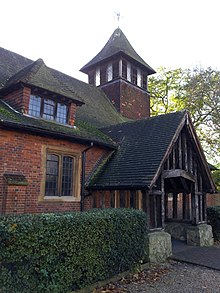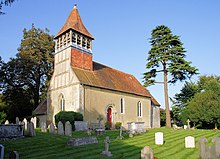
Kew is a district in the London Borough of Richmond upon Thames. Its population at the 2011 census was 11,436. Kew is the location of the Royal Botanic Gardens, now a World Heritage Site, which includes Kew Palace. Kew is also the home of important historical documents such as Domesday Book, which is held at The National Archives.
North Sheen is an area of London, England in the former Municipal Borough of Richmond (Surrey). It was incorporated into Kew in 1965 when the London Borough of Richmond upon Thames was created.

Oxted is a town and civil parish in the Tandridge district of Surrey, England, at the foot of the North Downs. It is 9 miles (14 km) south south-east of Croydon in Greater London, 9 miles (14 km) west of Sevenoaks in Kent, and 9 miles (14 km) north of East Grinstead in West Sussex.

Sir Arthur William Blomfield was an English architect. He became president of the Architectural Association in 1861; a Fellow of the Royal Institute of British Architects in 1867 and vice-president of the RIBA in 1886. He was educated at Trinity College, Cambridge, where he studied Architecture.

The Diocese of Southwark is one of the 42 dioceses of the Church of England, part of the worldwide Anglican Communion. The diocese forms part of the Province of Canterbury in England. It was created on 1 May 1905 from part of the ancient Diocese of Rochester that was served by a suffragan bishop of Southwark (1891–1905). Before 1877 most of the area was part of the Diocese of Winchester, some being part of the Diocese of London.

Bletchingley is a village in Surrey, England. It is on the A25 road to the east of Redhill and to the west of Godstone, has a conservation area with medieval buildings and is mostly on a wide escarpment of the Greensand Ridge, which is followed by the Greensand Way.

Godstone is a village and civil parish in the Tandridge District of Surrey, England. It is 6 miles (9.7 km) east of Reigate, 3 miles (4.8 km) west of Oxted, 22 miles (35 km) east of Guildford and 18 miles (29 km) south of London. Close to the North Downs and Blindley Heath. The Greensand Way and the North Downs Way both pass through Godstone.

Whyteleafe is a village in the district of Tandridge, Surrey, England, with a few streets falling inside the London Borough of Croydon. The village, in a dry valley of the North Downs, has three railway stations. Neighbouring villages and towns include Woldingham, Caterham, Coulsdon, Warlingham, and Kenley. To the west are Kenley Aerodrome, Kenley Common, Coxes Wood, and Blize Wood. To the east are Riddlesdown, the Dobbin and Marden Park.

Woldingham is a village and civil parish high on the North Downs between Oxted and Warlingham in Surrey, England, within the M25, 17.5 miles (28.2 km) southeast of London. The village has 2,141 inhabitants, many of whom commute to London, making Woldingham part of the London commuter belt. The village is served by the Oxted line and central London can be reached in 33 minutes by train.
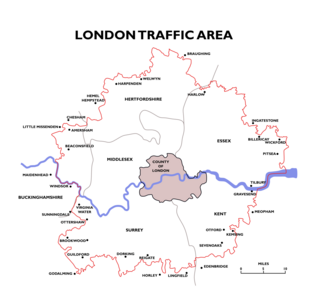
The London Traffic Area was established by the London Traffic Act 1924 to regulate the increasing amount of motor traffic in the London area. The LTA was abolished in 1965 on the establishment of the Greater London Council.

Crowhurst is a village and civil parish in the Tandridge district of Surrey, England. The nearest town is Oxted, 3 miles (5 km) to the north. Rated two architectural categories higher than the medieval church is the Renaissance manor, Crowhurst Place, which is a Grade I listed building.
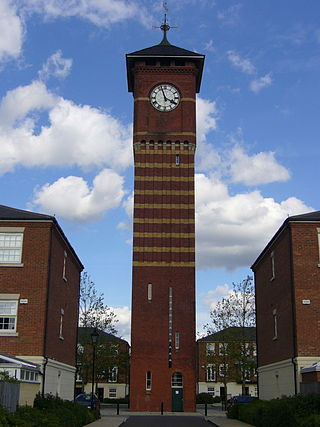
Chelsham is a village and former civil parish, now in the parish of Chelsham and Farleigh and the Tandridge district of Surrey, England. It is located in the Metropolitan Green Belt, 15.3 miles (24.6 km) from London, 3 miles (4.8 km) from Oxted and 23.8 miles (38.3 km) from Guildford. In 1961 the parish had a population of 1285.
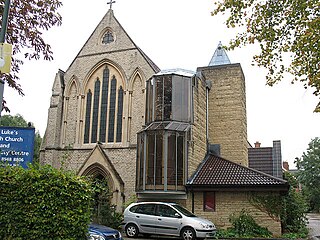
St Luke's Church, Kew, is a parish church in Kew, in the London Borough of Richmond upon Thames. It is part of the Church of England and the Anglican Communion and, locally, is a member of Churches Together in Kew. Together with St Philip and All Saints, it is one of two parishes within the united benefice of Kew, St Philip & All Saints with St Luke. Its vicar, Rev Dr Melanie Harrington, took up the role in June 2021. The church, built in the Gothic Revival style by architects Goldie, Child and Goldie, is also host to the Kew Community Trust and acts as a community centre.
Godstone Rural District was a rural district in Surrey, England from 1894 to 1974, covering an area in the south-east of the county.

St Mary Magdalene, Richmond, in the Anglican Diocese of Southwark, is a Grade II* listed parish church on Paradise Road, Richmond, London. The church, dedicated to Jesus' companion Mary Magdalene, was built in the early 16th century but has been greatly altered so that, apart from the tower, the visible parts of the church date from the 18th, 19th and early 20th centuries.

St Alban's, Cheam, also known as the Church of St Alban the Martyr, is one of three Church of England churches in the parish of Cheam in the London Borough of Sutton.
David Guy Blomfield was leader of the Liberal Party group on Richmond upon Thames Council, a writer, a book editor and a local historian.

Alfred Uvedale Miller Lambert (1870–1928) was an English local historian and antiquarian. He and his wife Cecily lived at South Park, Bletchingley, Surrey.
